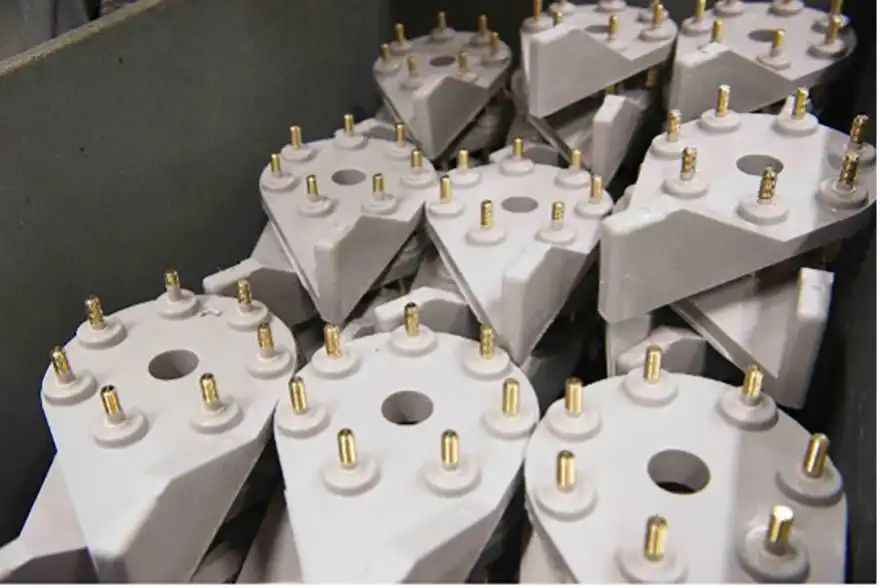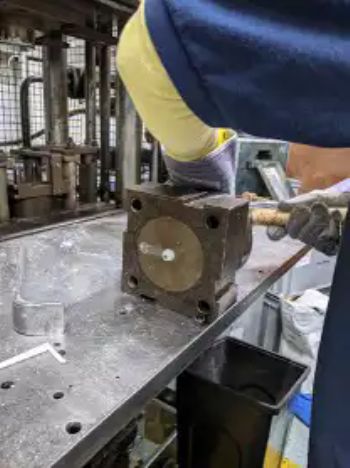 Inserted compression components are designed to be robust and need to be dimensionally stable
Inserted compression components are designed to be robust and need to be dimensionally stableThe cornerstone of advanced composite manufacturing in its 1920s Bakelite heyday, compression moulding was the key process for shaping thermoset materials. Despite the advent of more modern mass production techniques, including injection moulding, 3-D printing and LSR moulding, compression moulding still dominates in the manufacturing of durable, quality parts.
Thomas Catinat, operations manager at
Broanmain Plastics, explores the lasting legacy of compression moulding, including the application advantages of this technique. He said: “For stronger and more wear-resistant parts produced in lower volumes, compression moulding and direct screw transfer (DST) remain extremely valid and popular options.” For sectors like aerospace, automotive, transport, utilities, marine, electronics and renewable energy, compression moulding is undergoing a bit of a resurgence. This is mainly attributed to these industrial sectors using more advanced composite materials.
In many cases, compression moulded parts are more durable as a result of the tensile strength. Parts can also be more sustainable as bio-based materials are increasingly being used. Valued globally at $12.4 billion in 2023, the compression moulding market is projected to double to $25.1 billion by 2032.
A forming method that relies on heat and pressure to mould plastic materials, the first step in compression moulding involves creating a strong, precise metal tool. This is designed to the required dimensions and shape. A compression moulding machine then places partially heated material into the open, heated mould cavity. Broanmain Plastics offers compression moulding using Bulk Moulding Compound (BMC). This composite is a polyester ‘dough’ material that is manually put into the tool in pre-measured amounts.
 Pictured right: compression moulding remains a highly skilled and precise process, with demand anticipated to double in the next decade
Pictured right: compression moulding remains a highly skilled and precise process, with demand anticipated to double in the next decadeThe mould is closed with a top force or plug member, and pressure and heat is applied to ensure the material reaches all parts of the cavity. The part is then cured until the material sets into shape. Finally, the part is removed from the tooling where it is trimmed down. If intricate details are required, these are often created on a CNC mill. Mr Catinat said: “It is a highly skilled and precise process.”
DST is a hybrid of compression and injection moulding. It allows for the processing of thermoset materials such as epoxy, phenolic, DAP, alkyd and DMC in an injection moulding machine. Although more time is needed to change the equipment components and barrel, automation can significantly accelerate the process.
Mr Catinat added: “Although more labour-intensive than injection moulding, where the compression method is beneficial is shaping highly durable parts with significant thickness. The compression moulding tool makes even stiff and high durometer plastic materials perfectly vulcanised and dimensionally stable. It still works best on smooth surface parts that do not have complex geometries.”
Despite the strong outlook, accessibility to UK moulders with the capabilities and capacity to offer compression moulding and DST alongside mass injection moulding has fallen significantly. Mr Catinat concluded: “It is a process that Broanmain has continued to invest in. In order to adapt to our customers’ delivery needs and to ensure knowledge of this traditional technique is retained for future generations, most Broanmain machine operators are trained in both compression and injection moulding.”